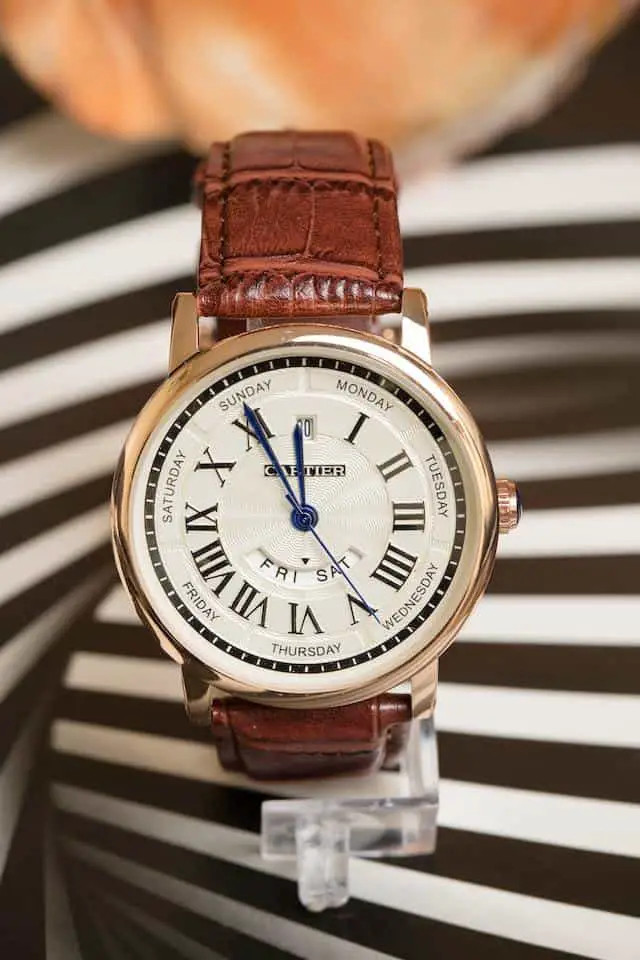Picture this: a luxurious face-off between two iconic fashion brands, Hermès and Cartier. For decades, Hermès and Cartier have been the undisputed leaders in luxury accessories. This Hermes vs. Cartier Case Study will take you on an enlightening journey through their captivating world.
In this comprehensive analysis, we’ll delve into the rise of sports-luxe watches as we compare Hermès’ innovative remix of the GMT travel watch complication with Cartier’s square-form Santos timepiece.
As luxury brands face unique challenges in today’s fast-paced market, our case study highlights how Hermès managed positive financial results during trying times.
We also explore how they maintain their status within an elite group of luxury fashion icons alongside Louis Vuitton and others by employing global expansion strategies and engaging customers through digital experiences like “Louis the Game.”
Collaborations are fueling popularity for these brands; from virtual real estate purchases on The Sandbox platform to exclusive partnerships such as Fendace – a collection that merges Versace and Fendi designs.
The Hermes vs. Cartier Case Study ultimately underscores the importance of upholding brand values while maintaining timeless design elements that define each brand’s identity.
Prepare to be immersed in a fascinating exploration that showcases both similarities and differences between these prestigious names in fashion history.
Table of Contents:
- The Rise of Sports-Luxe Watches: Hermes and Cartier’s Success Stories
- Challenges Faced by Luxury Brands: Overcoming Obstacles Together
- Challenges Faced by Luxury Brands
- Elite Group of Luxury Fashion Icons
- Collaborations Fueling Popularity: The Power of Creative Partnerships
- Upholding Brand Values and Timeless Design: The Secret Sauce of Hermes and Cartier
- Hermes vs. Cartier Case Study
- Conclusion
The Rise of Sports-Luxe Watches: Hermes and Cartier’s Success Stories
Let’s talk about luxury watches, shall we?
Hermes and Cartier have been making waves in the sports-luxe watch market, with both brands experiencing significant growth. In 2023 alone, Hermes’ watch sales rose by an impressive 55%, while Cartier’s Santos line has become increasingly popular among Gen Z consumers.
Hermes’ Innovative Remix of the GMT Travel Watch Complication
What sets these two luxury brands apart from the rest? For starters, Hermes took a fresh approach to their timepieces by remixing the classic GMT travel watch complication. Their unique take on this feature adds a touch of modernity to traditional designs that appeals to today’s discerning customers.
Cartier’s Square-Form Santos Timepiece
Moving on to Cartier. The brand is well-known for its iconic square-form Santos timepiece which has seen a resurgence in popularity recently.
Challenges Faced by Luxury Brands: Overcoming Obstacles Together
Despite their success, luxury brands like Hermes and Cartier face challenges in the market. One of the biggest challenges is dealing with hermes claims of copying their designs. However, these brands have shown resilience and have overcome these obstacles by working together and creating unique products that stand out in the market.
So there you have it. A quick look into how Hermes and Cartier continue to dominate the sports-luxe watch market while overcoming various obstacles along the way. If you’re interested in learning more about other iconic luxury fashion brands or exploring unique marketing strategies employed by them, stay tuned for our next sections.
Challenges Faced by Luxury Brands
Challenges have been aplenty for luxury brands like Hermes and Cartier, ranging from China’s crackdown on extravagant spending to the impact of terrorist attacks in France and Belgium. From waning demand due to China’s campaign against extravagant spending to decreased tourism following terrorist attacks in France and Belgium, the road hasn’t always been smooth sailing for these iconic fashion houses. In fact, Richemont reported a likely decline of about 45% in first-half operating profit – yikes.
But fear not. These giants know how to adapt and thrive even during tough times.
How Hermes Managed Positive Financial Results During Challenging Times
Hermes is known for its resilience and ability to bounce back from adversity with grace (and style). They managed an impressive growth rate despite facing global challenges such as economic downturns and pandemic-related restrictions on travel.
- Innovation: Hermes has consistently pushed boundaries with new designs while staying true to their heritage. Their pioneering attitude has enabled them to stay pertinent in the constantly evolving market environment.
- Diversification: By expanding into various product categories such as leather goods, fashion accessories, home furnishings, perfumes, etc., Hermes has successfully diversified its revenue streams which helps mitigate risks associated with external factors affecting specific industries or markets.
- Digitalization: The brand embraced digital channels early on by launching e-commerce platforms across different regions. This move allowed them to tap into a wider customer base and maintain sales during periods when brick-and-mortar stores were closed due to lockdowns.
What can we take away from Hermes’ achievements? By staying true to their brand values while adapting to changing market conditions through innovation, diversification, and digitalization, luxury brands like Hermes have managed not only to survive but also thrive in the face of adversity. Discover more about Hermes’ secrets for success here.
Luxury brands like Hermes and Cartier have faced challenges due to waning demand, economic downturns, and pandemic-related restrictions on travel. However, by adapting through innovation, diversification, and digitalization while staying true to their brand values, Hermes has managed positive financial results during challenging times. The key takeaway is that luxury brands can survive and thrive in the face of adversity by embracing change while remaining authentic.
Elite Group of Luxury Fashion Icons
Let us journey through the annals of time together.
Hermes and Cartier are part of an exclusive club that includes some of the most iconic luxury fashion brands in history. These esteemed labels have sustained their appeal and captivated audiences worldwide by embracing innovation, ingenuity, and staunchly adhering to their brand principles.
But wait, there’s more.
Louis Vuitton’s Adventure-Based Game “Louis the Game”
Founded in Paris in 1854, Louis Vuitton has always been at the forefront of innovation and creativity. To celebrate its founder’s 200th birthday, Louis Vuitton launched “Louis the Game”, an adventure-based mobile game featuring their mascot Vivienne. Isn’t it a fantastic way to interact with younger generations while maintaining their distinct branding?
The Global Expansion Strategy Employed by These Iconic Brands
Moving on to another legend: Chanel. Elegantly casual designs have been synonymous with Chanel since Gabrielle Chanel launched her brand over a century ago. Inspired by Coco herself, Karl Lagerfeld took this legacy forward as he expanded Chanel into new markets worldwide during his tenure as creative director from 1983 until his passing in 2023.
Last but not least: Prada. Prada opened its first store in Milan back in 1913 and has since grown into a global luxury powerhouse. Their expansion strategy includes opening flagship stores, collaborating with other brands, and even venturing into the world of art and culture.
These iconic brands have one thing in common: they’ve managed to stay relevant while expanding their reach globally through unique marketing strategies.
Want more insights on these legendary fashion icons? Dive deeper into our analysis here.
Collaborations Fueling Popularity: The Power of Creative Partnerships
Let’s talk about collaborations. In the world of luxury fashion, icons like Hermes and Cartier have boosted their popularity and market presence through strategic partnerships.
So, how do these iconic brands collaborate to create buzz?
Virtual Real Estate Purchase on The Sandbox Platform
First up, virtual real estate investments. Luxury brands are venturing into digital spaces such as The Sandbox platform, where they can purchase virtual land for marketing purposes or even launch exclusive products within the metaverse. Pretty cool, right?
Exclusive Fendace Collection Partnership between Versace and Fendi
Another exciting collaboration example is the “Fendace” collection, a partnership between two legendary fashion houses: Versace and Fendi. The result? A jaw-dropping fusion of both brand identities that took the fashion world by storm.
Key Takeaways from Successful Collaborations:
- Selective Partnerships: Choose your collaborators wisely. Partner with brands that share similar values or complement your own offerings.
- Creative Synergy: Ensure there’s creative harmony between both brands to develop a cohesive and innovative product or campaign.
- Authenticity: Stay true to your brand identity while exploring new avenues for growth through collaborations.
To sum it up, strategic collaborations can be a game-changer for luxury fashion icons like Hermes and Cartier. By joining with other imaginative powers, these brands keep on creating, extending their compass and staying applicable in a continually advancing commercial center.
If you’re eager to learn more about the world of luxury fashion, dive into our extensive collection of articles on 440 Industries.
Upholding Brand Values and Timeless Design: The Secret Sauce of Hermes and Cartier
Let’s talk about the magic ingredients that make Hermes and Cartier stand out in the luxury fashion world.
These brands have mastered the art of upholding their core values while creating timeless designs that resonate with consumers across generations.
Curious to know how they do it?
The Importance of Maintaining a Strong Brand Identity
Having a recognizable brand is paramount to succeeding in the luxury fashion world, an environment that’s highly competitive.
Hermes, for instance, has maintained its prestigious reputation by focusing on craftsmanship, quality materials, and exclusivity since its inception in 1837.
In a similar vein, Cartier has been guided by Louis Cartier’s motto “Never copy others; only create what you can’t find.”
Examples of Timeless Design Elements Present in Hermes and Cartier Products
- Hermes: The iconic Birkin bag, named after actress Jane Birkin. Its minimalist design combined with exceptional craftsmanship ensures it remains sought-after even today. Explore the history of the Birkin bag here.
- Cartier: The legendary Tank watch, designed in 1917 and inspired by military tanks. Its clean lines, rectangular shape, and Roman numeral dial make it a timeless classic. Discover more about Cartier’s Tank watches here.
To sum up, Hermes and Cartier have managed to stay at the top of their game by staying true to their brand values while consistently delivering timeless designs. Their unwavering commitment to quality craftsmanship has allowed them to remain relevant in an ever-changing market.
Want to learn more about luxury fashion? Dive deeper with 440 Industries’ expert analysis on trends and strategies.
Hermes vs. Cartier Case Study
When it comes to luxury fashion accessories, two brands that immediately come to mind are Hermes and Cartier. Both brands have a long-standing reputation for producing high-quality products that exude elegance and sophistication. In this case study, we will compare and contrast the two brands to see how they stack up against each other.
History and Reputation
Hermes was founded in 1837 by Thierry Hermes, and it started as a harness workshop that catered to European noblemen. Over the years, the brand expanded its offerings to include leather goods, fashion accessories, and perfumes. Today, Hermes is known for its iconic Birkin and Kelly bags, silk scarves, and watches.
Cartier, on the other hand, was founded in 1847 by Louis-Francois Cartier. The brand started as a jewelry store in Paris, and it quickly gained a reputation for producing exquisite pieces that were favored by royalty and celebrities. Today, Cartier is known for its jewelry, watches, and accessories.
Both brands have a long-standing reputation for producing high-quality products that are crafted with exceptional materials and meticulous attention to detail. However, Cartier is often associated with luxury jewelry, while Hermes is known for its leather goods and fashion accessories.
Product Offerings
Both Hermes and Cartier offer a wide range of products that cater to different tastes and preferences. Hermes is known for its leather goods, including bags, wallets, and belts. The brand also offers fashion accessories like scarves, ties, and hats. Additionally, Hermes has a line of perfumes and a range of watches that combine Swiss watchmaking techniques with the brand’s signature craftsmanship and design aesthetics.
Cartier, on the other hand, is known for its luxury jewelry, including engagement rings, bracelets, necklaces, and earrings. The brand also offers a range of watches that are crafted with exceptional materials and innovative designs. Additionally, Cartier has a line of leather goods and accessories, including bags, wallets, and belts.
Hermes Claims Against Cartier
In recent years, Hermes has filed several lawsuits against Cartier for allegedly copying its designs. Hermes claims that Cartier’s C de Cartier bag and its Clou bracelet are too similar to Hermes’ Birkin bag and Collier de Chien bracelet, respectively. While the lawsuits are still ongoing, it highlights the fierce competition between the two brands and the importance of protecting intellectual property in the luxury fashion industry.
Conclusion
Both Hermes and Cartier are iconic luxury brands that have a long-standing reputation for producing high-quality products that exude elegance and sophistication. While Hermes is known for its leather goods and fashion accessories, Cartier is often associated with luxury jewelry. However, both brands offer a wide range of products that cater to different tastes and preferences. Ultimately, the choice between the two brands comes down to personal preference and style.
Conclusion
Cartier Case Study, we have learned about the rise of sports-luxe watches and how these luxury brands faced challenges during difficult times. We also saw how elite fashion icons like Louis Vuitton expanded globally while upholding their brand values and timeless designs.
Collaborations are fueling popularity in the industry, with virtual real estate purchases on The Sandbox platform and exclusive collections like Fendace from Versace and Fendi. It is imperative to sustain a distinct brand image while incorporating modernity in order to stay competitive in this dynamic market.







